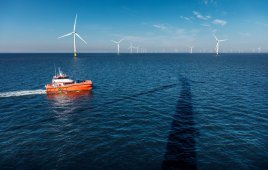This article is part of the 2017 Renewable Energy Handbook. A complete digital version is here: https://goo.gl/Sg4mHO
Mechanical couplings connect shafts so one can transmit rotational power to the other while accommodating some misalignment that is almost always present. For wind-turbine drivetrain applications, some designs are better suited than others.
Flexible couplings in wind turbines are used on the high-speed (the output) shaft of the gearbox to drive the generator. The task is made more difficult because the coupling is working in a nacelle where everything − gearbox and generator mostly − moves around, a bit thanks to the high vibration environment. While the gearbox and generator are bolted to a frame, it is not the large concrete inertia base frequently used in ground-level production settings.
Regarding misalignment, the couplings must accommodate it in considerable radial, angular, and axial form without wear and maintenance. In addition, couplings should provide electrical insulation, an ability to handle loads well beyond the normal application needs, and weigh as little as possible for easy installation.
One such coupling, from Zero-Max, provides an example of the features useful to a wind turbine. For instance, it is available as an upgrade replacement for existing wind turbines and for OEM applications. The company says the design has been tested under conditions simulating a 20-year load spectrum of continuous operation. In addition, the turbine couplings are said to handle torque spikes and high misalignment issues.
The coupling comes with composite disk packs (the elements that let it flex) at both ends of a center spacer and is made of composite or steel. Composite disk packs provide a distinct advantage over other coupling designs by allowing for a surplus of parallel and axial misalignment while remaining torsionally rigid through all harmonic ranges of a wind turbine’s oscillating load.
The coupling further protects the generator and gearbox bearings by transferring lower reaction loads. And, the lack of conductive properties of the composite material make it useful for electrically insulating the turbine’s generator from the gearbox, thereby eliminating stray currents that can leak across a coupling and damage gearbox bearings and gear teeth.
The composite materials also withstand all types of environmental elements, including temperature extremes from -40 to 70°C, along with moisture and chemicals common to wind-turbine nacelles. Designed for onshore and offshore turbine drivetrains with capacities up to 5 MW, the couplings are said to provide extreme endurance in a lightweight package.
Lastly, the units are easy to install either on the production floor or in the cramped, up-tower environment and they operate well in new OEM turbines or existing drivetrains. Standard models and sizes include single and double flex models with clamp style hubs with or without keyways. The torque capacities range from 40 Nm to 1,436 Nm and beyond with speed ratings from 4,400 to 17,000 rpm.
Filed Under: Couplings, O&M




